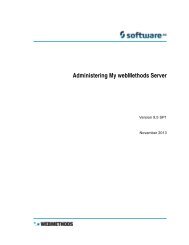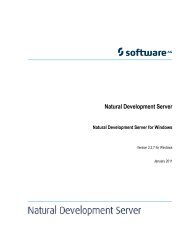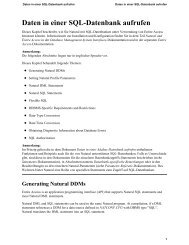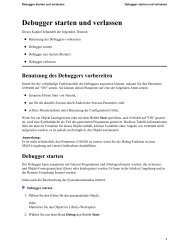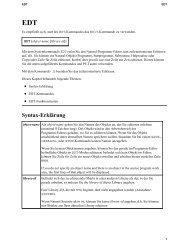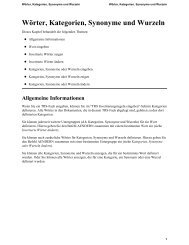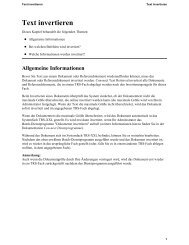Ending Entire System Server - Software AG Documentation
Ending Entire System Server - Software AG Documentation
Ending Entire System Server - Software AG Documentation
Create successful ePaper yourself
Turn your PDF publications into a flip-book with our unique Google optimized e-Paper software.
Dynamic <strong>Server</strong> Management Concepts<br />
Unlike z/OS, under BS2000/OSD, z/VSE, a fixed number of server tasks/subtasks are started in<br />
<strong>Entire</strong> <strong>System</strong> <strong>Server</strong> in order to process user requests. Under z/OS, there is a 1:1 relationship<br />
between user and subtask, that is, there is one subtask started for each user.<br />
Use of a fixed number of server tasks/subtasks is due to operating system architecture, as under<br />
both BS2000/OSD, z/VSE the main <strong>Entire</strong> <strong>System</strong> <strong>Server</strong> task may create only a limited number of<br />
tasks/subtasks.<br />
A dispatcher gives user requests to individual servers. The servers use the security profile of the<br />
user and process the request accordingly. Under BS2000/OSD, the server with the least load will<br />
process the new request. Under z/VSE, the first available server will process the request. If none<br />
are available, the request will wait until a subtask is free.<br />
However, when using a fixed number of tasks/subtasks, problems may occur. This design cannot<br />
adequately react to different workloads. In case of many requests, the servers may not be able to<br />
process the requests quickly enough, resulting in delays. Likewise, during idle times <strong>Entire</strong> <strong>System</strong><br />
<strong>Server</strong> cannot release resources.<br />
For this reason, the Dynamic <strong>Server</strong> Management (DSM) was created. As of <strong>Entire</strong> <strong>System</strong> <strong>Server</strong><br />
Version 3.1.1 ( BS2000/OSD, z/VSE), it enables systems programming staff and operations to dynamically<br />
control servers, i.e., to start or stop them as necessary. A minimum number of servers<br />
are started during initialization of <strong>Entire</strong> <strong>System</strong> <strong>Server</strong>, which will be automatically increased in<br />
case of a large number of user requests up to a definable upper limit. Delays during request processing<br />
can thus be avoided to a large degree.<br />
In case of idle times, servers are stopped until a definable lower limit is reached.<br />
The dispatcher mentioned above determines if incoming requests can be processed with the current<br />
server configuration, and increases the number of servers if necessary.<br />
A monitor function checks at regular intervals whether too many servers are idle and stops<br />
tasks/subtasks as necessary.<br />
Under BS2000/OSD, the most important aid to recognizing bottlenecks is the queue depth as<br />
measured by the dispatcher, i.e., how many requests are pending for processing by a server. If<br />
this value reaches a definable limit, another server will be started and selected for processing the<br />
new request. Under z/VSE, new tasks are created when a new request is received and all active<br />
servers are busy with other requests (this will change in a future release).<br />
Idle times are measured based on when a server is finished with a user request. If the monitor<br />
finds that the idle time exceeds that specified at startup, the server will be terminated.<br />
Administration<br />
Common <strong>Entire</strong> <strong>System</strong> <strong>Server</strong> Features<br />
93




